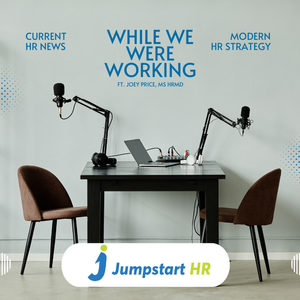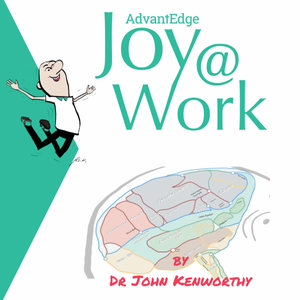
Internal Hiring vs External Hiring - What’s Better? Ft. Fit Small Business
03/12/24 • 32 min
Summary
This episode’s conversation explores the topic of internal versus external hiring in small businesses. Experts from Jumpstart HR and the Fit Small Business team discuss the key differences between the two methods, including the impact on cost, time efficiency, employee morale, retention rates, and diversity of skill sets. They also provide a five-step framework to determine whether to fill a role with an internal hire or an external hire, which includes assessing current skills and gaps, identifying growth and development opportunities, conducting a cost benefit analysis, considering cultural fit and adaptability, and evaluating long-term impact and strategic alignment.
Takeaways
- Internal and external recruitment methods have different impacts on cost, time efficiency, employee morale, retention rates, and diversity of skill sets.
- A five-step framework can help small businesses determine whether to fill a role with an internal hire or an external hire: assess current skills and gaps, identify growth and development opportunities, conduct a cost benefit analysis, consider cultural fit and adaptability, and evaluate long-term impact and strategic alignment.
- Communication, performance reviews, and feedback are important in assessing current skills, identifying growth opportunities, and promoting internal candidates.
- Cost considerations include compensation, benefits, and potential expenses for external hiring, while internal hiring may involve salary adjustments and filling previous positions.
- Cultural fit and adaptability should be considered when deciding between internal and external candidates, as well as the long-term impact and alignment with business goals.
Chapters
00:00 Introduction
03:23 Key differences between internal and external recruitment methods
06:00 Cost implications of internal versus external hiring
08:46 Time efficiency of internal and external recruitment methods
14:16 Effect of internal and external recruitment on employee morale and retention
16:31 Impact of internal and external candidate recruiting strategies on diversity of skill sets
21:57 Step 1: Assessment
24:30 Step 2: Identifying
28:04 Step 3: Costs
31:24 Step 4: Culture
31:54 Step 5: Long-term impact and strategic alignment
To learn more about Internal vs External Hiring, visit @FitSmallBusiness’s Helpful Guide: https://fitsmallbusiness.com/internal-vs-external-recruiting
To subscribe to Fit Small Business, visit: https://link.fitsmallbusiness.com/join/65m/hr-social-signup
To work with Jumpstart HR’s team of HR professionals, visit our website: www.jumpstart-hr.com
Summary
This episode’s conversation explores the topic of internal versus external hiring in small businesses. Experts from Jumpstart HR and the Fit Small Business team discuss the key differences between the two methods, including the impact on cost, time efficiency, employee morale, retention rates, and diversity of skill sets. They also provide a five-step framework to determine whether to fill a role with an internal hire or an external hire, which includes assessing current skills and gaps, identifying growth and development opportunities, conducting a cost benefit analysis, considering cultural fit and adaptability, and evaluating long-term impact and strategic alignment.
Takeaways
- Internal and external recruitment methods have different impacts on cost, time efficiency, employee morale, retention rates, and diversity of skill sets.
- A five-step framework can help small businesses determine whether to fill a role with an internal hire or an external hire: assess current skills and gaps, identify growth and development opportunities, conduct a cost benefit analysis, consider cultural fit and adaptability, and evaluate long-term impact and strategic alignment.
- Communication, performance reviews, and feedback are important in assessing current skills, identifying growth opportunities, and promoting internal candidates.
- Cost considerations include compensation, benefits, and potential expenses for external hiring, while internal hiring may involve salary adjustments and filling previous positions.
- Cultural fit and adaptability should be considered when deciding between internal and external candidates, as well as the long-term impact and alignment with business goals.
Chapters
00:00 Introduction
03:23 Key differences between internal and external recruitment methods
06:00 Cost implications of internal versus external hiring
08:46 Time efficiency of internal and external recruitment methods
14:16 Effect of internal and external recruitment on employee morale and retention
16:31 Impact of internal and external candidate recruiting strategies on diversity of skill sets
21:57 Step 1: Assessment
24:30 Step 2: Identifying
28:04 Step 3: Costs
31:24 Step 4: Culture
31:54 Step 5: Long-term impact and strategic alignment
To learn more about Internal vs External Hiring, visit @FitSmallBusiness’s Helpful Guide: https://fitsmallbusiness.com/internal-vs-external-recruiting
To subscribe to Fit Small Business, visit: https://link.fitsmallbusiness.com/join/65m/hr-social-signup
To work with Jumpstart HR’s team of HR professionals, visit our website: www.jumpstart-hr.com
Previous Episode

NYC’s AI Bias Law Isn’t Working + Demystifying Employee Ratings
Summary
In this episode, Joey Price and Sommer Ketron discuss New York City’s AI bias law and the challenges it faces in terms of enforcement and compliance. They also evaluate the use of numerical ratings in performance reviews, highlighting the pros and cons of this approach. The conversation emphasizes the importance of clear communication in performance management and offers assistance in developing effective performance rating systems.
Takeaways
New York City’s AI bias law, which requires employers to audit automated employment decision tools for potential bias, has faced challenges in terms of compliance and enforcement.
The law’s narrow scope and lack of awareness among employers contribute to low compliance rates.
Numerical ratings in performance reviews provide clarity and a means of quantifying performance, but they can also be subjective and demotivating.
Alternative approaches to performance reviews that focus on feedback and improvement without assigning numerical scores may be more effective.
Clear communication and evaluation of performance rating systems are crucial for successful performance management.
Chapters
00:00 - Introduction and Overview
01:54 - Discussion of New York City’s AI Bias Law
03:55 - Challenges and Non-Compliance with the Law
08:30 - Enforcement and Compliance Issues
15:10 - Numerical Ratings in Performance Reviews and Pros and Cons of Numerical Ratings
20:00 - Clarity and Subjectivity of Numerical Ratings
26:01 - Alternative Approaches to Performance Reviews
28:00 - Importance of Communication in Performance Management
28:27 - Assistance with Performance Rating Systems
30:07 - Conclusion
If you like this episode you’ll love
Episode Comments
Generate a badge
Get a badge for your website that links back to this episode
<a href="https://goodpods.com/podcasts/while-we-were-working-your-weekly-small-business-hr-news-and-strategy-244595/internal-hiring-vs-external-hiring-whats-better-ft-fit-small-business-46528306"> <img src="https://storage.googleapis.com/goodpods-images-bucket/badges/generic-badge-1.svg" alt="listen to internal hiring vs external hiring - what’s better? ft. fit small business on goodpods" style="width: 225px" /> </a>
Copy




